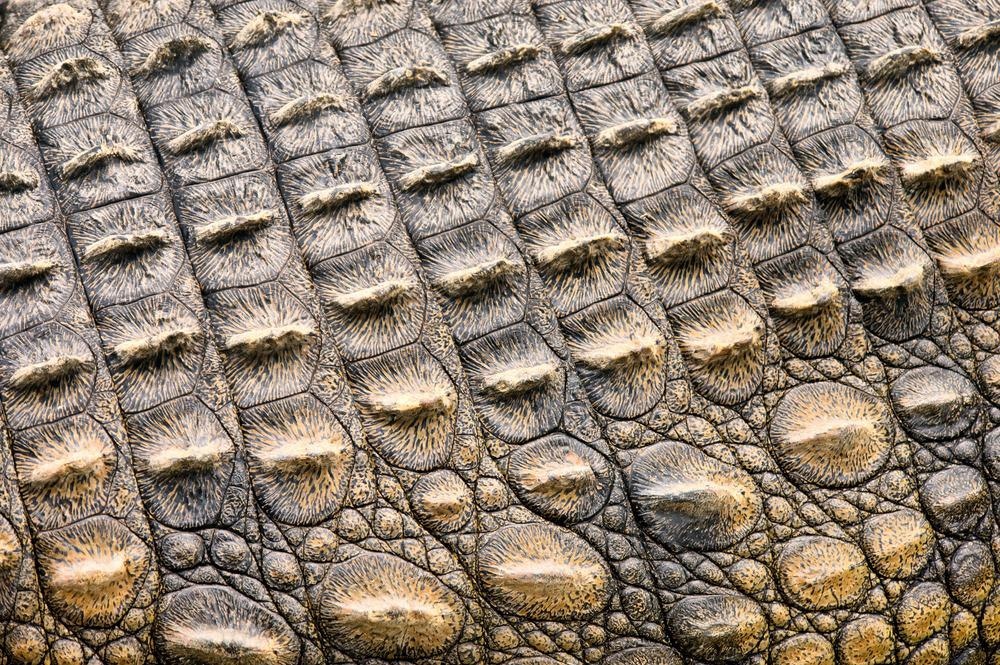Biomimetic structural design offers advantages for the development on flexible lithium-ion batteries, and a study published in Energy Storage Materials has demonstrated the novel design of a device inspired by crocodile skin.

Study: Crocodile skin inspired rigid-supple integrated flexible lithium-ion batteries with high energy density and bidirectional deformability. Image Credit: PhotoSky/Shutterstock.com
Flexible batteries are a key technology in the field of flexible and wearable electronics. The design of these devices has been extensively investigated by several researchers over the past decade, with different device architectures and materials developed and explored.
Designing Efficient Flexible Lithium-ion Batteries
The world is currently going through what has been widely termed the fourth industrial revolution. Amongst the technological advances that are promising to disrupt society, flexible, wearable devices such as sensors, biomedical devices, displays, and telecommunications devices have been the subject of intense research in recent years.
Wearable devices must possess good mechanical deformity and electrochemical and material properties. For this reason, every part of them must be fully flexible and able to withstand significant mechanical stress whilst retaining superior electrochemical performance.
Lithium-ion batteries have shown great promise as energy storage components for flexible devices due to being lightweight and possessing a long cycle life and higher power output. However, most currently available lithium-ion batteries on the market do not have the required flexibility and ability to withstand mechanical deformation whilst retaining satisfactory electrochemical performance.
Whilst several fully flexible lithium-ion batteries are in the research and development stage and new materials have been widely explored, issues with the devices persist which hinder their widespread commercial application. Repeated deformation of these batteries can accelerate mechanical failure.
For instance, interface delamination can occur between the current collector and the active layer. This can lead to fluctuations in power output and cause short circuits and other safety and degradation issues.
Strategies to Improve Lithium-ion Battery Flexibility
To overcome these issues, several strategies have been proposed to develop robust flexible lithium-ion batteries. Materials which possess elastic, soft, and stretchable properties have been developed. These include solid electrolytes, super slim electrodes, and carbon-based current collectors.
Moreover, there has been research focus on developing batteries with novel architectures that can withstand deformation, such as wavy 2D structures, origami, micro-honeycomb, and soft serpentine structures. Despite being able to handle mechanical deformation without damage, they suffer from reduced energy density.
More from AZoM: Particle Analysis Applied to Additive Manufacturing Feedstocks
Recent advances in the field of flexible battery development have aimed to design devices with a two-part structure that separately hold deformation and energy storage functions. Researchers have developed accordion-like, zigzag-shaped, and knee-joint mimicking structures.
Whilst these devices possess both superior flexibility and energy density, they cannot achieve bidirectional deformability, which occurs in the real world due to folding, winding, and stretching. Wearable devices require both high energy density and multi-direction flexibility.
Designing a fully flexible lithium-ion battery which can withstand multi-directional deformation whilst retaining superior electrochemical properties such as high energy density is a key concern within current research in the field of wearable electronics.
The Study
Writing in Energy Storage Materials, the authors behind the new study have presented an approach that can overcome these issues. They have presented a novel design inspired by crocodile skin. Crocodiles have evolved to be apex predators over the course of millions of years. This is in part due to their armor.
Crocodile skin is tough but flexible. Scutes are the bony ridged plates (scales) that make up this tough skin and possess a bony base. Arrays of rigid scutes connected by soft dermis occur all over the body, including at points that undergo significant levels of mechanical deformation, such as shoulders and joints.
The proposed rigid-supple integrated flexible lithium-ion batteries in the research can be coiled directly from a stacked and tailored electrode sheet using a winding machine. Two adjacent electroactive parts in the row direction are connected by diagonal joints, and there is an interspace between adjacent parts. The design allows for greater bidirectional bending compared to conventional high-density flexible lithium-ion batteries.
Superior energy storage capacity is offered by the thick, winding electroactive parts. Results of the study demonstrated a superior energy density of 400.2 Wh L-1. The energy density of the design reaches 91.76% of conventional non-flexible lithium-ion batteries with the same geometric volume and materials. Performance over two hundred charge/discharge cycles was also good, with a 92.3% battery capacity retention under multiple deformations, up to 30,000 bidirectional bending/folding.
After 13,000 dynamic bending test cycles, the battery’s discharge capacity exceeded 151.9 mAh g-1. Finite element analysis revealed the device’s electrode protection mechanism. Results demonstrated that most of the mechanical stress was borne by the supple interconnected joints, and the maximum principal stresses of the proposed device were significantly smaller than conventional prismatic lithium-ion cells under the same bent state.
In addition, the authors have stated that the proposed design is highly customizable due to the ability to adjust multiple geometric parameters. The crocodile skin-inspired flexible lithium-ion battery presented in the study shows enormous potential for use in technologies such as wearable devices, flexible displays, and soft robotics.
Disclaimer: The views expressed here are those of the author expressed in their private capacity and do not necessarily represent the views of AZoM.com Limited T/A AZoNetwork the owner and operator of this website. This disclaimer forms part of the Terms and conditions of use of this website.
Source:
Liu, G et al. (2022) Crocodile skin inspired rigid-supple integrated flexible lithium ion batteries with high energy density and bidirectional deformability [online] Energy Storage Materials [pre-proof] sciencedirect.com. Available at: https://www.sciencedirect.com/science/article/pii/S2405829722000691